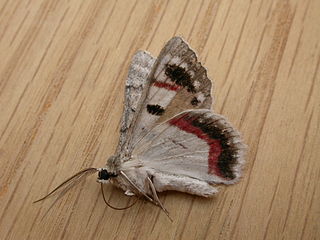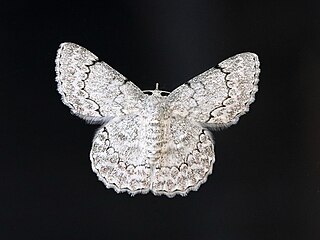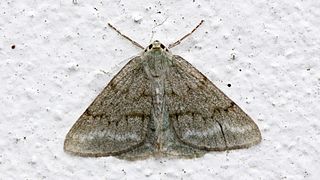
Crypsiphona ocultaria the red-lined looper moth or red-lined geometer, is a moth of the family Geometridae. The species was first described by Edward Donovan in 1805 and it is found in Australia.

Hypodoxa muscosaria, the textured emerald, is a moth of the family Geometridae first described by Achille Guenée in 1857. It is found along the east coast of Australia.

Hypodoxa is a genus of moths in the family Geometridae described by Prout in 1912.
Paraterpna is a monotypic moth genus in the family Geometridae. It consists of only one species, Paraterpna harrisoni, which is found in New South Wales, Australia. Both the genus and species were first described by Gilbert M. Goldfinch in 1929.

Pingasa chlora, the white looper moth or flower-eating caterpillar, is a species of moth of the family Geometridae first described by Caspar Stoll in 1782. It is found in Sundaland, the Philippines, Sulawesi and from the Moluccas to Queensland, Australia.

The Pseudoterpnini are a tribe of geometer moths in the subfamily Geometrinae. The tribe was described by Warren in 1893. It was alternatively treated as subtribe Pseudoterpniti by Jeremy Daniel Holloway in 1996.
Hypodoxa bryophylla, the green looper moth, is a moth of the family Geometridae. The species was first described by Gilbert M. Goldfinch in 1929. It is found in the Australian states of Victoria, New South Wales and Queensland.
Hypodoxa conspurcata is a moth of the family Geometridae first described by Thomas Pennington Lucas in 1898. It is found in Australia, including Queensland.

Hypodoxa emiliaria is a moth of the family Geometridae first described by Achille Guenée in 1858. It is found in Australia, New Guinea and on the Solomon Islands.
Hypodoxa erebusata is a moth of the family Geometridae first described by Francis Walker in 1860. It is found in Australia, including Queensland.
Hypodoxa horridata is a moth of the family Geometridae first described by Francis Walker in 1863. It is found in Australia, including New South Wales.
Hypodoxa multicolor is a moth of the family Geometridae first described by William Warren in 1899. It is found in Australia and New Guinea.
Hypodoxa paroptila is a moth of the family Geometridae first described by Alfred Jefferis Turner in 1906. It is found in Australia, including Queensland.
Hypodoxa corrosa is a moth of the family Geometridae first described by William Warren in 1907. It is found on New Guinea.
Hypodoxa involuta is a moth of the family Geometridae. It was first described by Louis Beethoven Prout in 1933 and is found on Buru in Indonesia.
Hypodoxa leprosa is a moth of the family Geometridae first described by William Warren in 1907. It is found on New Guinea.
Hypodoxa lichenosa is a moth of the family Geometridae first described by William Warren in 1907. It is found on New Guinea.
Hypodoxa regina is a moth of the family Geometridae first described by Louis Beethoven Prout in 1916. It is found on New Guinea.
Hypodoxa viridicoma is a moth of the family Geometridae first described by William Warren in 1899. It is found on the Solomon Islands.
Pingasa cinerea, the tan-spotted grey, is a moth of the family Geometridae. The species was first described by William Warren in 1894. It is found in the Australian states of New South Wales, Queensland, Tasmania and Victoria.




